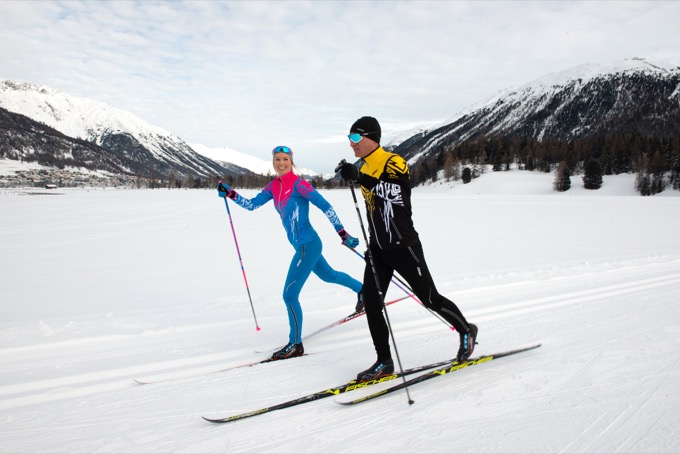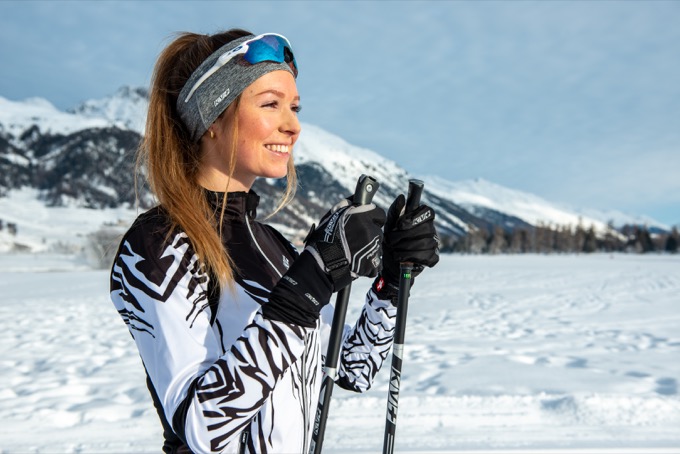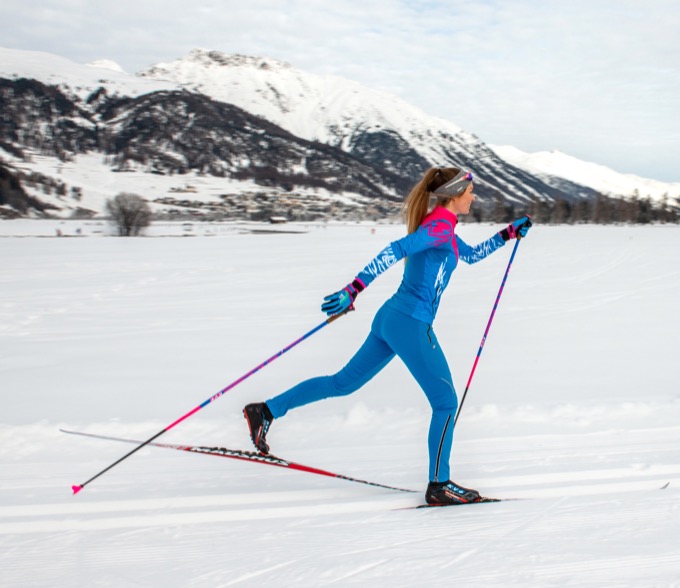
It may be hard to believe if you’re a beginner, but buying the right cross country ski poles will improve your skiing experience.
Think of it this way: a cross country skier uses all four limbs to move forward. Depending on the technique, perhaps 40 – 100% of your propulsion comes from forces working through your poles.
The material, the features and the length of your poles are all important considerations. You need poles that fit your body, your needs and your budget.
This article covers everything you need to know about buying cross country ski poles, including how to calculate pole length for skate and classic skiing.
Quick Takeaways
- Pole length influences your ski technique.
- You should not use the same poles for skate and classic cross country skiing. (Classic poles are ~10 cm shorter than skate poles.)
- Classic Ski Poles Length Quick Calculation – Your height minus 30 cm, or to the top of the shoulders, or 1-2 cm below.
- Skate Ski Poles Length Quick Calculation – Your height minus 20 cm, or to approximately midway between the bottom of the chin and the lower lip.
- More expensive poles have nicer grips, are made of lighter, stiffer materials and have a nicer swing feel.
- They transmit power better and significantly contribute to efficiency.
- The harnesses come in different sizes. Be sure they fit over your hand and glove.
- Rollerski pole lengths are the same as used on snow.
Table of Contents
Pole Length and Ski Technique
The basic posture for skate and classic skiing is to be slightly flexed at the hips, knees and ankles. We never stand completely upright in cross country skiing. The whole body leans forward and the weight is often biased towards the balls of the feet. This posture, called the athletic stance, is the foundation for all ski techniques.
Pole length influences ski technique because it can affect your basic posture and your balance.
When your poles are the right length, you can get into a good basic position. Ski poles that are too long may force you to stand too upright. That makes it more challenging to balance. Shorter poles may cause a skier to hunch over and won’t provide as good propulsion.
Did you know we have instructional cross-country ski videos?
For skiers just getting started:
Help for struggling skate skiers: The One Skate Dance Drill
Ski Pole Materials and Features
Poles are made of aluminium, carbon or composite material. The best poles are:
- Lightweight – to reduce the energy needed to carry them.
- Stiff – to improve the transmission of forces through the poles and into the ground. The stiffness of a pole can decrease with age.
Ideally - Weighted/Engineered – to improve how the pole feels in the hand as it swings like a pendulum.
- Carbon fibre poles are most expensive and have the best performance for stiffness and weight. Carbon poles are also the most fragile and may be prone to breaking.
Aluminum poles are cheapest. They are heavy and sturdy.
Composite poles are a mix of materials, including carbon. There are many mid-range composite ski poles that offer excellent value for money.
Pole Handles and Harnesses
Buy a harness strap, not a loop strap, if you can. The harness will hold the pole in your grasp effortlessly and distribute the pressure evenly across your hand.
Pole harnesses come in different sizes and are expensive to replace. Test different harnesses to find what’s most comfortable for you.
Make sure you buy a harness that fits over your glove or mitten. Get help adjusting the fit when you buy them.
The handle material also affects the weight and comfort of the pole. Cork handles are warmer to the touch than manmade materials, but cork wears down more quickly with use.
Some ski pole handles have quick release mechanisms that disengages the strap from the pole, even while the harness is still wrapped around your hand. Biathletes use poles like that so they can shoot without having to remove their hands from the harness.
The drawback of quick-release poles is that’s another thing that can break or wear out. You may find the strap disengages, even when you don’t want it to.
Pole Tips
Pole tips come with different sized baskets. Large baskets are good for deep and/or soft snow. Small baskets are ideal for well groomed and hard-packed snow.
Pole tips need periodic sharpening. This can be done with a file or a dremel tool.
Some poles have screw-in tips which allow you to easily swap out tips for various conditions and uses.

How to Calculate Pole Length
You can determine your pole length with mathematical formulas or in reference to landmarks on your body. I prefer landmarks as the formulas are less reliable for people at the ends of the spectrum for height (shorter or taller).
Height and body landmarks are the primary factors to consider when determining pole length, but there are other factors to consider as well. For example, you may want longer poles if:
- You ski mostly on flats (around lakes, for example).
- You have a very strong upper body (you have enough power to propel yourself forward with longer poles).
- You do a lot of double poling.
You may prefer slightly shorter poles if:
- You ski on difficult courses with lots of steep climbs (because you naturally bend lower forward on uphills).
- Your upper body is not very strong.
Anatomical Landmarks for Determining Ski Pole Length
Stand in ski boots or street shoes and measure to approximately the top for the shoulder for classic poles (or slightly lower).
For skate ski poles, measure to approximately midway between the bottom of the chin and the lower lip.
Formulas for Calculating Ski Pole Length
To calculate your ski pole length, you’ll need to know:
- The manufacturer’s pole length
- Your height
Manufacturer’s Pole Length
Cross country ski poles come in lengths that increase in 5 cm increments.
Most manufacturers calculate pole length from the tip to the top of the pole handle. A few brands calculate pole length to where the strap inserts into the grip.
Your Height
“Your height” means your actual height, not standing in shoes.
Notes: These formulas are a good rule of thumb, but may need slight adjustments. Taller individuals may need to cut their poles a little more and shorter individuals (like children) may need to cut their poles a little less. So, for example, when calculating a classic ski pole length a 195 cm adult may want a pole 35 cm shorter than their height, while a child may want a pole 25 cm shorter than their height.
Formula for Classic Ski Pole Length
Your height (cm) – 30 cm= Classic pole length (cm)
Formula for Skate Ski Pole Length
Your height (cm) – 20 cm= Skate pole length (cm)
Example Calculation for Skate Skis
- Your height: 178 cm
- New ski pole length: 160 cm to top of handles
- Your ideal skate pole length: 158 cm
- Recommendation: cut poles 2 cm.
Cutting Ski Poles to Custom Lengths
Cross-country ski poles may be cut to custom lengths. The cut is made at the handle end, not the tip end of the pole.
The handle grip is glued to the pole shaft with hot melt glue, which is softened by heating. Handles covered by plastic or rubber can be headed in hot water. Not warm, hot.
Handle grips covered by natural cork must be heated with dry air with a heat gun or over the stove. Heat handle slowly and evenly so you don’t burn the cork. Take your time and let heat penetrate through the handle. Remember that you need to melt the glue underneath the handle!
Once the glue is soft, you can pull the grip off shaft . The shaft is cut and the handle reattached. Be careful cutting carbon poles. The carbon fibers run the length of the pole and may peel down, which you don’t want to happen.
If needed, a Nordic Ski Shop will usually cut new poles for free at the time of purchase, or for a small fee.
Regulation Classic Ski Pole Length (FIS)
The World Ski Federation limits classic ski pole length used in FIS races to 83% of the skiers height as calculated in ski boots. You only need to worry about that if you plan to ski in FIS sanctioned races.

Buying Advice
If you are a budget-minded new skiers, try to make room in your budget for a low to mid-range composite pole, not an aluminum pole and buy a pole with a harness grip, not a simple loop strap.
Not all poles have handles that can be removed. If you need to cut the poles to customize the length, then make sure you buy poles that have a handle that can removed.
If you can afford it and you’re sure cross country skiing is going to be your new passion, buy more expensive poles. Treat them well. They are a little fragile and it’s heartbreaking to snap a beloved pole.
Ski Poles for Roller Skiing
Roller skis are elevated off the ground by the wheels, but roller ski poles are the same length as snow ski poles. Why is that?
The extra height of a roller ski is offset by the fact that the poles don’t sink into the ground like they do on snow.
So, you can use the same poles for roller skiing and on-snow skiing, but you need to swap out the pole tips.
Roller ski pole tips are made of a much harder material (carbide). Regular pole tips will wear down immediately if you use them on pavement.
Roller ski tips should be sharpened often. It’s hard for a blunt worn down tip to bite into the pavement.
Protecting Your Poles
More expensive, carbon poles are sadly more prone to breakage.
- Store and transport your poles with care.
- If the snow is deep and ungroomed, it may be best to leave your favourite poles at home.
- The snow to the edge of the trail is often softer. If the pole tip sinks deeply and you are poling forcefully you run a higher risk of breaking the pole.


